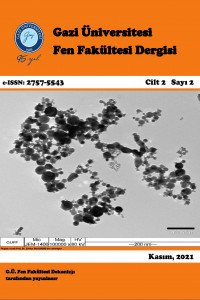Üç Değişkenli Fibonacci Tipli Polinomlar için Doğurucu Fonksiyonlar ve Bazı Özellikleri
Bu çalışmada ilk olarak iyi bilinen bazı polinom ailelerinin ve özel sayıların tanımlarına yer verilmiştir. Daha sonra Fibonacci tipli polinom ve sayı ailelerini içeren yeni doğurucu fonksiyonlar tanıtılmıştır. Bu polinom ailelerinin açık gösterimi ve doğurucu fonksiyonlarının kısmi türevleri ile bu ailelerin rekürans bağıntıları elde edilmiştir.
Anahtar Kelimeler:
Doğurucu fonksiyon, Fibonacci polinomları, Rekürans bağıntısı
___
- [1] Koshy, T. (2001). Fibonacci and Lucas Numbers with Aplications. Pure and Applied Mathematics, Canada: John Wiley and Sons, Interscience, 1-500.
- [2] Grigas, A. (2013). The Fibonacci Sequence, Its history, significance and manifestations in Nature. A Senior Thesis Submitted in Partial Fulfillment of the Requirements for Graduation in the Honors Program, Liberty University, 1-35.
- [3] Posamentier, A.S. and I. Lehmann (2007). The (fabulaus) Fibonacci numbers. Amherst, New York: Prometheus Books, 299-305.
- [4] Catalani, M. (2004). Some formula for bivariate Fibonacci and Lucas polynomials. ArXiv: Math/0406323v1 [Math. CO].
- [5] Hoggatt, V.E. Jr. and Bicknell M. (1972). Convolution Triangles. The Fibonacci Quarterly, 10(6), 599-608.
- [6] Lupas, A. (1999). A guide of Fibonacci and Lucas polynomials. Octagon Mathematics Magazine, 7(1), 2-12.
- [7] Feinberg, M. (1963). Fibonacci-Tribonacci. The Fibonacci Quarterly, (3), 70-74. [6] Lupas, A. (1999). A guide of Fibonacci and Lucas polynomials. Octagon Mathematics Magazine, 7(1), 2-12.
- [8] Hoggatt, V.E. Jr. and Bicknell M. (1972). Convolution Triangles. The Fibonacci Quarterly, 10(6), 599-608.
- [9] Hoggatt, V.E. Jr. and M. Bicknell (1973). Generalized Fibonacci polynomials. Fibonacci Quarterly, 11(5), 457-465.
- [10] Elia, M. (2001). Derived sequences, the Tribonacci recurrence and cubic forms. The Fibonacci Quarterly, 39(2), 107-109.
- [11] Kocer, E. G. and Gedikce, H. (2016). Trivariate Fibonacci and Lucas polynomials. Konuralp Journal of Mathematics, 4(2), 247-254.
- [12] Erkuş-Duman, E. And Tuğlu, N. (2015). Generating functions for the generalized bivariate Fibonacci and Lucas polynomials. Journal of Computational Analysis and Aplications, 18(5), 815-821.
- [13] Kızılateş, C. and Çekim, B. (2018). New families of generating functions for q-Fibonacci and the related polynomials. Ars Combinatoria, 136, 397-404.
- [14] Kızılateş, C. and Tuğlu, N. (2017). A new generalization of convolved (p, q)-Fibonacci and (p, q)- Lucas polynomials. Journal of Mathematics and Computer Science. 7(6), 995-1005.
- [15] Tuğlu, N., E.G., Koçer and Stakhov, A. (2011). Bivariate Fibonacci like p-polynomials. Applied Mathematics and Computation, 217(24), 10239-10246.
- [16] Ozdemir, G. and Simsek, Y. (2016). Generating functions for two-variable polynomials related to a family of Fibonacci type polynomials and numbers. Filomat, 30(4), 969-975.
- [17] Ozdemir, G. (2017). Çok Değişkenli Fibonacci Tipli Polinomlar İçin Üreteç Fonksiyonları ve Uygulamaları, Doktora Tezi, Akdeniz Üniversitesi Fen Bilimleri Enstitüsü, Antalya, 52-67.
- [18] Kızılateş, C., Çekim, B., Tuğlu, Naim., Kim, T. (2019). New families of three-variable polynomials coupled with well-known polynomials and numbers. Symmetry, 11(2), 264.
- [19] Humbert, P. (1920). Some Extensions of Pincherle’s Polynomials. Proceedings of the Edinburg Mathematical Society, 39, 21-24.
- [20] Bell, W.W. (1968). Special Function for Scientist and Engineer. London: D. Van Nostrand Company Ltd., 247p.
- [21] Srivastava, H.M. and Manocha, H.L. (1984). A Treatise on Generating Functions. New York, USA: Ellis Harwood Limited.
- Yayın Aralığı: Yılda 2 Sayı
- Başlangıç: 2020
- Yayıncı: Gazi Üniversitesi
Sayıdaki Diğer Makaleler
Yunus ÖZEN, Halil İbrahim EFKERE, Tarik ASAR, Süleyman ÖZÇELİK
Türkiye’nin Asker Böcekleri (Cantharidae) Faunistik Çalışması
Neslihan BAL, Hüseyin ÖZDİKMEN
Polimer Kompozitlerin Üretiminde Elyaf Oryantasyonunun Etkileri
Biyolojik Sistemli Nanopartiküller
İrem YAVUZ, Ebru Şebnem YILMAZ
Üç Değişkenli Fibonacci Tipli Polinomlar için Doğurucu Fonksiyonlar ve Bazı Özellikleri
Balıktan İzole Edilen Hareketli Aeromonas Türlerinin Bazı Ekstrasellüler Enzimlerinin Belirlenmesi
Kompakt Olmayan Yıldız Graf Üzerindeki Selfadjoint Olmayan Schrödinger Operatörünün Spektral Analizi
